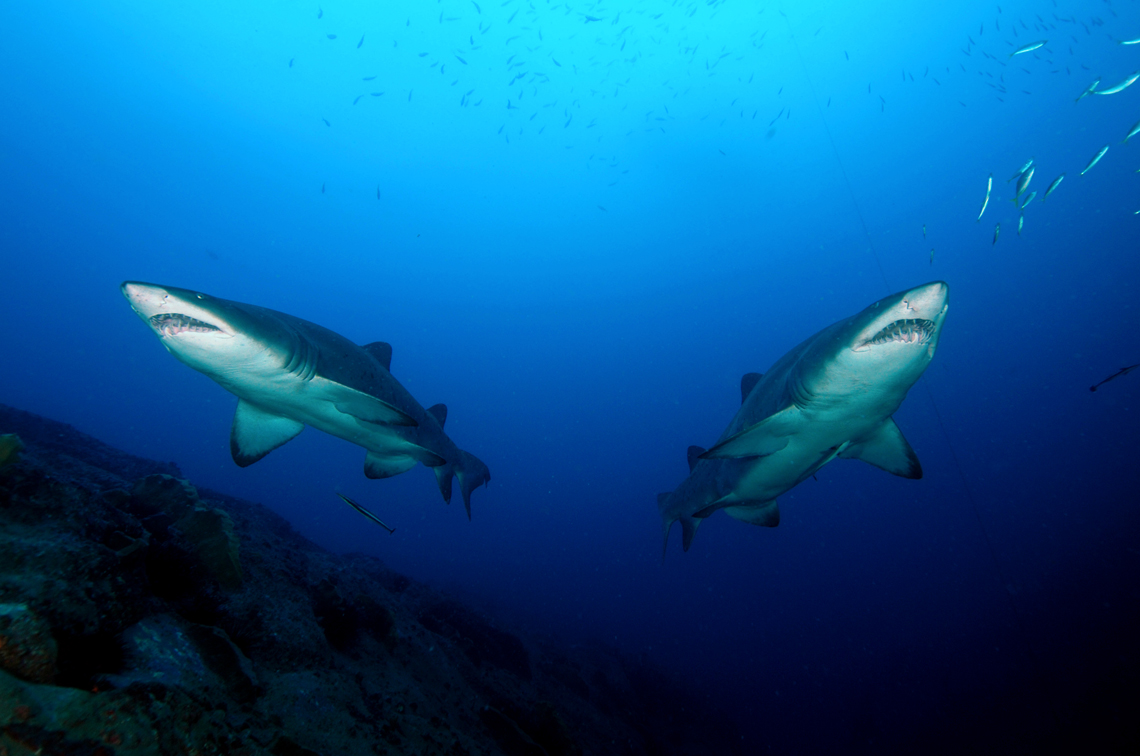Australia’s eastern grey nurse shark population is listed as Critically Endangered under the Environment Protection and Biodiversity Conservation Act 1999 and the species is one of 100 highlighted in the 2021–2031 Threatened Species Strategy. The Recovery Plan for the Grey Nurse Shark identifies research and actions needed to improve the shark’s population status and ensure its long-term conservation.
Research funded by the Marine Biodiversity Hub (a forerunner of the Marine and Coastal Hub) and led by CSIRO and the New South Wales Department of Primary Industries and Regional Development (NSW DPIRD) provided the first robust estimate of adult abundance. The eastern grey nurse shark adult population was estimated at 2000 (950–3100), with the population trend increasing at 3% a year. Based on this finding, the research leaders concluded that existing recovery actions were effective, but that measures in place – such as protection of aggregation sites from all forms of fishing to protect the shark from incidental capture – should not be removed.
To improve the accuracy of this population estimate as a basis for decisions about conservation management, researchers needed new estimates of species length, age and growth. This project refined the abundance and trend estimate for the eastern Australian adult grey nurse shark population through research that combined rigorous biological sampling, genetic analysis and statistical modelling.
The number of adults in the eastern grey nurse shark population was estimated to have increased by about 5% annually between 2017 and 2023, from about 1096 to 1420 adults. The new research methods and breadth of data provided by this project have enabled a strong evidence base for the Australian and NSW governments to assess conservation actions for the eastern grey nurse shark population.

Grey nurse sharks. Image: David Harasti
Approach and findings
NSW DPIRD researchers collected biopsy samples from more than 300 grey nurse sharks off NSW, from the Solitary Islands off Coffs Harbour down to Cabbage Tree Island off Port Stephens, in depths ranging from eight metres at shallow sites such as Hayden’s Reef off Forster, to 30 m at sites such as Fish Rock off South-West Rocks. The new samples were sourced from live animals released via the NSW SMART drumline program, in addition to targeted scuba diving surveys. Scuba divers trained in safe biopsy techniques used a hollow stainless-steel biopsy tip attached to a hand spear with a purpose-built quick release adaptor. In a procedure involving minimal interaction, a diver would approach a shark underwater and obtain a small tissue sample at close range, while a second diver operated a stereo-video camera system to record an accurate length measurement.
The DNA from the tissue samples was profiled to reveal family relationships that can help to estimate population size, using a method called ‘close-kin mark-recapture’. This technique developed by CSIRO combines advanced genetics and statistical modelling. It works on the premise that the number of close-kin pairs (in this study, two animals that share a parent) in a population relates directly to the size of the adult population. For example, samples from a small adult population typically would display a high rate of close-kin pairs, while samples from a large adult population would display a low rate of close-kin pairs. CSIRO researchers analysed the DNA of 376 tissue samples collected from grey nurse sharks to identify the close-kin pairs. (Twenty-one parent-offspring (POP) pairs, six full sibling (FSP) pairs, and 148 half sibling (HSP) pairs were identified.)
New, accurate length information derived from the stereo-video sampling was used to estimate the age of sharks using a new model developed specifically for Australian grey nurse sharks that links the shark’s age to its length. The accurate estimation of the sampled shark’s age was an important input into the close-kin mark recapture population estimate. Due to a lack of Australian data and models, previous estimates had been based on data from other countries in the species’ range.
Acoustic tagging projects undertaken in NSW provided an opportunity to investigate juvenile survival rates. Survival is expected to be high for GNS based on their low reproductive output strategy. Initial results indicated juvenile survival for ages 0 to 4 to be approximately 85% per annum, with the survival of older ages increasing to at least 90% per annum. This result, should be taken with caution due to the small sample size and possible male bias. The results indicate that there is information on survival from telemetry data from internally implanted long-life acoustic tags. Further tagging should focus on females and the youngest available animals.
A single DNA sample provided by Northern Territory Fisheries was compared with DNA from both the eastern and western grey nurse shark populations. The NT sample genetically aligned more closely with samples from the western population.
Outcomes
This project provided a more precise estimate of the abundance of Australia’s eastern grey nurse shark population, and reduced uncertainty surrounding the trend in abundance. The Australian and New South Wales governments have a stronger evidence base for making decisions about the species’ recovery and conservation.
Project location
Worimi (Broughton Island, Seal Rocks and Forster, NSW; Biripi (Cod Grounds and Southwest Rocks, NSW); Gumbainggir (Coffs Harbour, NSW); Krauatungalung, Tatungalung and Brataualung (Gippsland, Victoria) and Nipaluna (Hobart, Tasmania).
Project leaders
Russell Bradford
CSIRO
Research partners
CSIRO
New South Wales Department of Primary Industries
Research users
Department of Climate Change, Energy, the Environment and Water
NSW Department of Primary Industries and Regional Development
